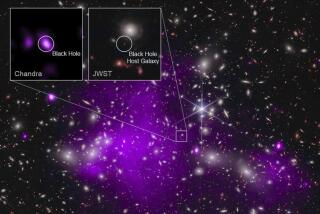Hubble Gives Best Clues Yet of Black Holes
- Share via
WASHINGTON — Scientists using the National Aeronautics and Space Administration’s Hubble Space Telescope have found the most compelling evidence yet produced for the existence of stupefying massive objects called black holes.
Saying they now have a chance to resolve the debate as early as 1994, they released space telescope photographs of a swirling disk of dust, shooting jets of energy across 88,000 light-years of space.
“It is the best look we have ever had at the workings of the nuclear engine at the center of an active galaxy,” said Walter J. Jaffe, a one-time Cal Tech student who is now an astronomer at the University of Leiden in the Netherlands. “We haven’t seen a black hole itself, but we are seeing as close to a black hole as we have ever seen before.”
A black hole is predicted by both Sir Isaac Newton’s and Albert Einstein’s laws of physics. It should form when intense pressure, such as a supernova explosion, makes an object extremely compact, resulting in a surface gravity so powerful that nothing can travel fast enough to escape. Outside, no part of the black hole is visible, because even light is trapped. Inside, time and space act in unfamiliar ways.
Jaffe said at a press conference that he believes there is a black hole with a mass perhaps 10 million times that of the sun at the center of the disk. He theorizes that the enormous energy, streams of electrons flowing out at nearly the speed of light, is generated when material sucked into the hole is converted into energy by temperatures thousands of times hotter than the sun.
The disk photographed by the space telescope is at the core of an elliptical galaxy of 100 billion stars about 45 million light-years from Earth in the galactic cluster Virgo.
Some 300 light-years across, the outer fringe of the disk is rotating at about 50 miles per second, Jaffe said, while the inner region is rotating at perhaps 3,000 miles per second, under the influence of its massive core.
“It is almost certain,” Jaffe told reporters, “that this disk is the material that is feeding the black hole, and it is almost certain that it is the spinning of this disk that provides the orientation of the two jets (of energy).”
“We are really seeing into the fiery furnace, finally, after all these years,” said Pennsylvania State University’s Daniel W. Weedman, who said he remains an agnostic in the black hole debate. “We have gotten the door open.”
Bruce Margon, chairman of the astronomy department at the University of Washington, agreed.
“Almost every bit of the puzzle is in place now . . . “ he said. “We now see something that is almost too good to be true.”
As they presented their photo of the disk Thursday, Jaffe and NASA officials said they may be able to confirm the existence of a black hole at its core as early as 1994, after NASA flies its scheduled 1993 mission to repair the Hubble’s incorrectly ground mirror.
Once the repair mission is flown, a “faint objects spectrometer” will be able to precisely determine the motion of stars in the galaxy and calculate the mass of the object at the center of the disk.
“We don’t yet know what is down there in the center of the hole,” Weedman told Jaffe during the press conference on Thursday. “I grant you that you have found an incredibly powerful source of gravity. As to what is making that energy, we are a long way from saying we understand it.”
But Margon said confirmation of a black hole’s existence should be straight forward once the faint objects spectrometer can be trained on the disk.
“What is going to convince most people,” he said, “is to actually know the speed of the stars in the very center of this galaxy. Then, using that measurement and Newton’s laws of gravity, we can directly weigh the central object. If we discover that it is extremely massive, like 100 million times the mass of our sun and extremely compact, then there will probably be no alternative to a black hole.”
Thursday’s disclosure followed a spate of announcements, including two from Hubble experiments, adding weight to arguments that black holes may be fairly commonplace throughout the universe.
This latest observation provides a glimpse beyond the previous ones, according to investigator Holland Ford of Johns Hopkins University. “This is the first case where we can follow the disk’s gas in an orderly way down to the immediate environment of the black hole,” he said.
The concept of black holes, Weedman suggested, developed in large measure as a convenient response to questions that had no conventional answer. In spite of evidence from the space telescope and improved ground-based observatories, he noted, there still do not exist concepts or equations to fully explain the gravitational forces being attributed to black holes. Scientists long believed that elliptical galaxies, such as the one where the disk spins through the universe, contained little or no dust, a conclusion that has been reversed in recent years.
When asked where the dust could have come from to create the disk now a source of intense interest, Jaffe suggested that it resulted from an incident of cosmic cannabalism.
“The easiest thing to say,” he said, “is that it swallowed another galaxy . . . that it ate another galaxy that was going by.”






